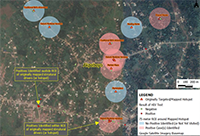Geospatial clustering of newly diagnosed HIV infected adults in Cross River State helps define new “hotspots”
DOI:
https://doi.org/10.17532/jhsci.2020.912Keywords:
Hotspots , HIV/AIDS , geographic information system , geospatial , clustering , transactional sex , maritime workAbstract
Introduction: A hotspot is a geographical location having evidence of high STIs/HIV prevalence, and/or behaviors that put people at high risk of becoming infected. Therefore, Nigeria, with almost two million people living with HIV, could be considered a giant “hotspot.” The main aim was to describe how the geospatial clustering of newly diagnosed HIV-infected adults in Cross River State helps define new “hotspots.”
Methods: Secondary data collected between January 2020 and March 2020, identified and mapped around a presumed hotspot’s radius of influence (ROI), were analyzed using a “Hotspot Analysis” plugin in QGIS software. With a sample size of 3019, both seropositive and seronegative results were geo-referenced and the resultant map was analyzed to determine HIV-positive clusters.
Results: From the 3019 spatial locations mapped, 720 (23.9%) were positive cases. Of these, 328 (45.6%) were thus estimated as being associated with the presumed hotspots. The remaining 392 (54.4%) were positive cases identified outside of the ROI of the originally presumed hotspots. The total number of mapped HIV testing services (HTS) points (both negative and positive cases) within the hotspot ROI was 1319, while those outside of the hotspot ROI were 1700.
Conclusion: Unique hotspots where social gatherings occur tended to have a wider ROI. Targeted testing in these hard-to-reach communities is recommended.
Downloads

Downloads
Published
Issue
Section
Categories
License
Copyright (c) 2020 Michael Egbe, Antor O. Ndep, Philip Imohi, Kingsley Obase, Frank Eyam, Cajetan Obi, Peter Agada, Nnennaya Igwe, Augustine Idemudia, Ikechukwukah Abah, Betta Edu

This work is licensed under a Creative Commons Attribution 4.0 International License.










